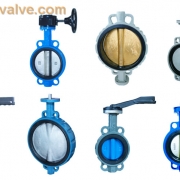Precautions for the use of triple eccentric metal seated butterfly valve
Triple eccentric hard-sealed butterfly valves are generally metal seated butterfly valves, which have an eccentric metal sealing structure. Sealing forms include metal-to-metal sealing, stainless steel plate and graphite composite plate sealing ring to metal sealing, etc. The driving methods are mainly electric, manual, turbo rod transmission,

D673H-16C-stainless steel pneumatic triple eccentric butterfly valve
pneumatic and so on. The triple eccentric hard-seal butterfly valve is very popular in the market. It maintains the advantages of the centerline butterfly valve and discards the disadvantage of the poor sealing performance of the metal seal. It is a more promising product in the market. Let’s take a look at the problems we need to pay attention to in use:
1. The triple eccentric hard sealing butterfly valve is a multi-layer soft and hard stacked sealing ring, which is also a very significant feature of the triple eccentric hard sealing butterfly valve. The seat sealing ring is composed of multiple layers of stainless steel sheets on both sides of the soft T-shaped sealing ring. When the valve plate is in the normally open state, the medium will form a positive scouring on its sealing surface, and the soft sealing tape in the metal sheet sandwich will directly affect the sealing performance after being scoured.
2. The valve will be restricted by the structural conditions, so the structure is not suitable for valves with a diameter below DN200, because the overall structure of the valve plate will be too thick and the flow resistance will be large.
3. The principle of the valve’s triple eccentric structure. The sealing between the sealing surface of the valve plate and the valve seat is to press the valve plate against the valve seat by the torque of the transmission device. It is a self-sealing property. That is, when the medium is flowing in the forward direction, the higher the medium pressure, the tighter the sealing and squeezing. However, in general, when the flow channel medium flows back, as the medium pressure increases, the unit positive pressure between the valve plate and the valve seat is less than the medium pressure, the seal will begin to leak.
Is there a solution to the inability to achieve two-way sealing? Butterfly valve manufacturers add an adjustment ring between the pressure plate and the valve seat to achieve a very ideal two-way hard seal. The sealing surface of the valve plate and the valve seat of the triple eccentric sealing butterfly valve is an oblique cone structure, and temperature-resistant and corrosion-resistant alloy materials are surfacing welded on the oblique cone surface of the valve plate. A structure in which the spring fixed between the pressure plate of the adjusting ring and the adjusting bolt of the pressure plate are assembled together. This structure effectively compensates for the tolerance zone between the shaft sleeve and the valve body and the elastic deformation of the valve stem under the medium pressure, and solves the sealing problem of the valve in the two-way interchangeable medium conveying process.
When the medium flows backward, the seal between the valve plate and the valve seat depends on the torque of the driving device to press the valve plate against the valve seat. With the increase of the reverse medium pressure, when the unit positive pressure between the valve plate and the valve seat is less than the medium pressure, the deformation energy stored by the spring of the adjusting ring after being loaded compensates for the tight pressure of the sealing surface of the valve plate and the valve seat Play the role of automatic compensation.
The triple eccentric hard seal butterfly valve adopts a soft T-shaped multi-layer stainless steel sheet on both sides to form a sealing ring. It has the dual advantages of metal hard and soft sealing, and has zero leakage sealing performance regardless of low temperature and high temperature. In the future, it may also replace gate valves and ball valves.
TH Valve is a professional manufacturer of butterfly valve, gate valve, check valve, globe valve, knife gate valve, ball valve with API, JIS, DIN standard, used in Oil, Gas, Marine industry, Water supply and drainage, fire fighting, shipbuilding, water treatment and other systems, with Nominal Diameter of DN50 to DN1200, NBR/EPDM/VITON, Certificates & Approvals: DNV-GL, Lloyds, DNV, BV, API, ABS, CCS. Standards: EN 593, API609, API6D
Related news/knowledge:
The sealing characteristics and principle of eccentric butterfly valve
Selection and application of eccentric butterfly valve
Precautions for butterfly valve maintenance
Installation method and precautions of check valve

 tanghaivalve.com
tanghaivalve.com

 © Copyright 2020 Tianjin Tanghaidongyang Valve Co., Ltd. All Rights Reserved.
© Copyright 2020 Tianjin Tanghaidongyang Valve Co., Ltd. All Rights Reserved.